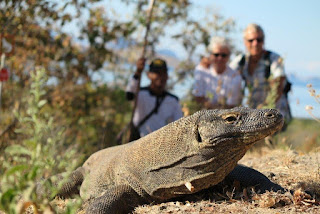 |
| Finally, Laurie caught a fish! |
Exmouth is on the northwest-most corner of Australia and is about 730 miles from our ultimate destination, Fremantle. The area is famous for the Ningaloo Reef and whale sharks, so we may spend some time here exploring before heading on to Fremantle.
During our trip from Dampier, we had three overnight anchorages, the first night at Eaglehawk Island, about 16 miles west of Dampier. The second night we anchored at Great Sandy Island, which was about 67 miles from Eaglehawk Island. The third day we sailed another 70 miles to Serrurier Island and then today, the last leg in to the harbor at Exmouth which was about 35 miles.
 |
| Sunrise departure from Eaglehawk Island |
Ok, the story of the fish.
Our fishing success has become a bit of a joke as the only luck I had
catching fish was to purchase them from local fishermen along the way :).
But finally today, while sailing at nearly 8
knots between Great Sandy Island and Exmouth, we hooked a nice Wahoo, which is
in the Mackerel family. This fish must have been desperate if he actually went
for my lure, given I have trolled for hundreds of ocean miles with no luck.
 |
| Sunset from Great Sandy Island was brilliant. |
Our fishing technique while sailing consists of 300 feet of
300 pound test line, then a long wire leader and a lure of some sort. We caught this fish on a nice large and very
pink plastic squid! We tie the 300 lb
test off on the boat with a length of bungee cord, and when that cord snaps
tight (indicating fish on) we simply wind the free end of the line on to a
winch and grind her in, not even slowing down. This is definitely a fishing for meat sort of activity,
not so much sport. But we will enjoy the
fish immensely. In fact, Eric is making mackerel
sushi for dinner, and I am sure we will be eating lots of fish in the coming
days…but thankfully Katmai has an excellent freezer as well.
 |
| Thousands of seabirds on the northwest shelf. |
 |
| Humpback whale spy-hopping in the distance |
Our trip from Dampier was delightful. I am so glad that we opted to day sail though
the islands and reefs rather than go offshore and sail around the clock.
The second and third days we saw numerous pods of humpback
whales, many of which put on a fabulous show of breaching, spy-hopping and
flipper flapping. I bet we saw more than
50 whales total.
We also saw our first sea turtles, both at sea and around
our boat while at anchorage. And the bird life was fabulous, with hundreds
seabirds of many species all around us.
We have not seen this sort of abundance of sea life since we
left Alaska. What a fabulous coast.











